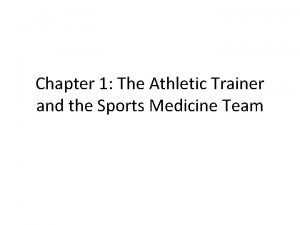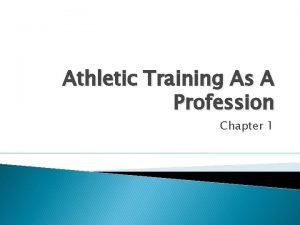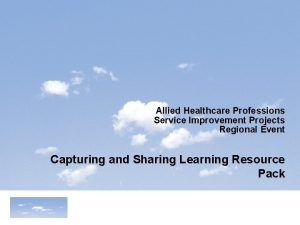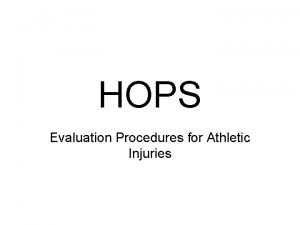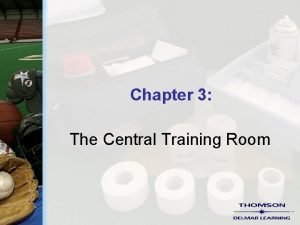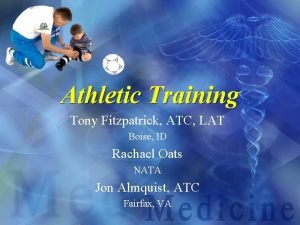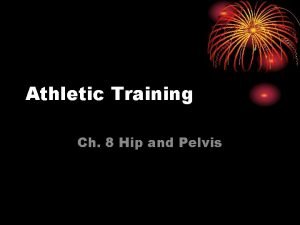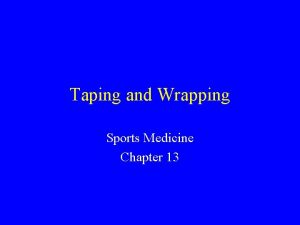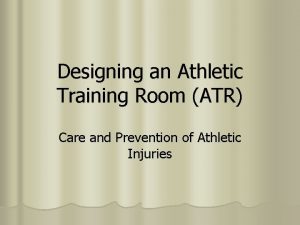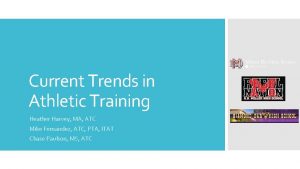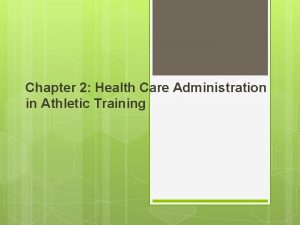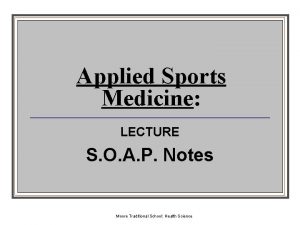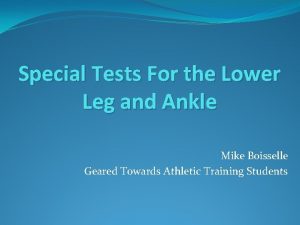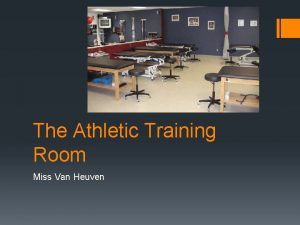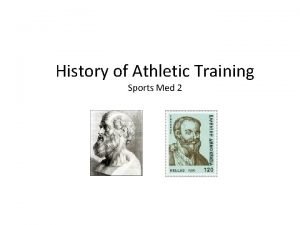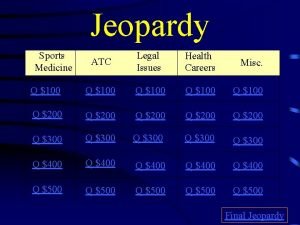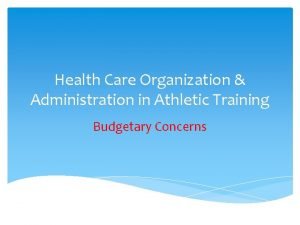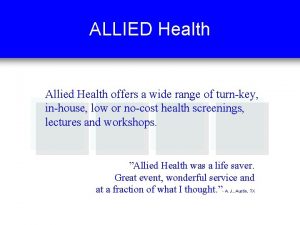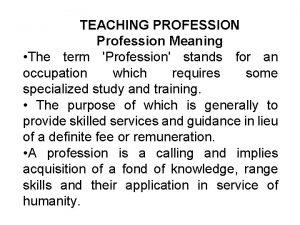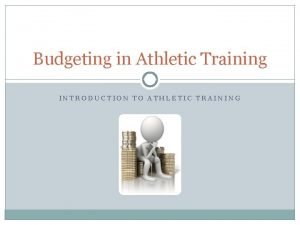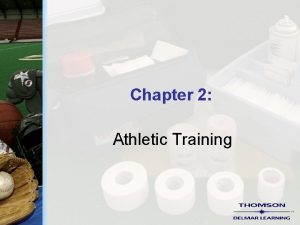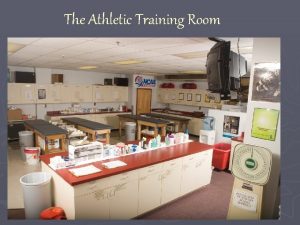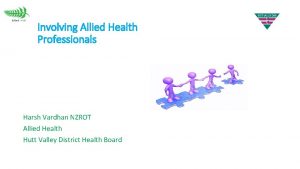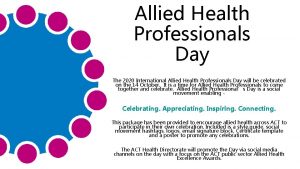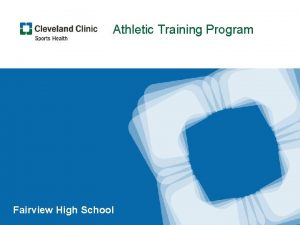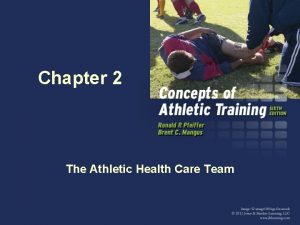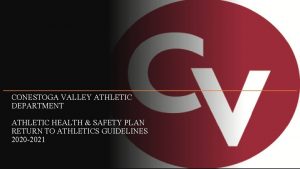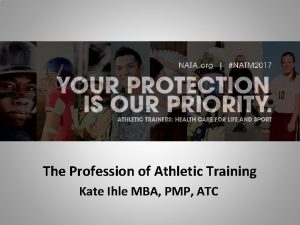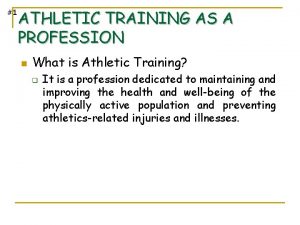Athletic Training An Allied Health Profession What is























- Slides: 23

Athletic Training: An Allied Health Profession

What is an Athletic Trainer? A certified athletic trainer is an allied health professional. Educated and trained to provide healthcare for the athletic and physically active population. ATCs work together with other health professionals.

History of Athletic Training Began in late 19 th century with the establishment of intercollegiate and interscholastic sports. In the beginning the extent of the AT profession included. . . “Rub down” Application of counterirritants Prescription of home remedies In 1950 the NATA was formed. Purpose? 3

National Athletic Trainer’s Association To set profesional standards Promote professional meetings to exchange ideas Create and promote research Work as an entity for ONE purpose 4

Sports Medicine American College of Sports Medicine (ACSM) defined SM as multidisciplinary including Physiological Biomechanical Psychological Pathological phenomena 5

What is The Job of an ATC? Prevent Assess Treat Rehabilitate Athletic Injuries

Typical Responsibilities of an ATC Injury Evaluation Teaching Injury Management Wellness Rehabilitation Event Coverage Treatment Supervision of Staff Budgeting/Purchasing Specific responsibilities will vary based on the setting

Where Do They Work? High schools Colleges/Universities Professional Sports Clinics/Hospitals Corporate Settings

Requirements to Become an ATC Coursework: Earn 4 year bachelor’s degree Must be in an accredited program Pass the NATABOC certification exam Anatomy & Physiology Exercise Physiology Sport Psychology Sport Ethics Nutrition AT Clinicals Evaluation Techniques Rehabilitation Techniques

Continuing Education To maintain certification, athletic trainer must: ü Acquire 80 CEUs every 3 years ü Must be through approved NATABOC programs ü Update CPR and First Aider Certification

Domains & Competencies NATABOC created 5 domains an entry-level ATC should possess Education council created 12 competencies that should be taught. 11

5 Domains ATCs Practice Preventing athletic injuries Recognition, evaluation, and immediate care Rehabilitation Education and guidance of patients, coaches, and parents Healthcare administration

Prevention of Injury Health assessments to identify previous or pre- disposing conditions. o Achieved by use of Preparticipation Exams (physicals) Supervision and inspection of environmental conditions, equipment, and protective devices. Application of functional taping, bracing, wrapping, and supports. Educating athletes, coaches, spectators, and parents on injury and prevention

Recognition, Evaluation, and Immediate Care of Injury and illness Develop an injury management plan (i. e. EAP) Administer First Aid Obtain a medical history Inspect, palpate, and perform specific evaluation and functional tests Make proper medical referral, when necessary

Rehabilitation and Conditioning • Implement a rehab program following protocols Ø Follow doctor’s orders when necessary (i. e. post surgery) • Adjust program according to patient’s progress • Evaluate athlete’s willingness to RTP

Education and Guidance Develop and implement educational programs to help reduce injury rate and illness Promote healthy lifestyles Develop guidance programs for drug, alcohol, psychological, and nutrition issues Develop in service programs to meet needs of staff, athletes, patients, etc.

Healthcare Administration Maintain update medical records Establish emergency action plan Establish guidelines for injury management and referral Develop review system to ensure maintenance of high quality care Insurance processing Budgeting

Personal Qualities of the ATC Stamina and Ability to adapt Empathy Sense of humor Communication Intellectual Curiosity Ethical Practice Professional Memberships 18

The Athletic Trainer & the Athlete The athlete must always be informed. May also be required to inform the parents/ guardian. 19

Team Physician Compiling Medical Histories Diagnosing Injury Deciding on disqualification and Return to Play. Attending Practices and Games. Committing to Sports and the Athlete. 20

We Need ATCs!!! Recent date collected by NATA shows… • Patient satisfaction is over 96% when treated by ATC • AT methods are effective for treating injuries and illness • Studies show quick intervention by ATs reduces surgery probability and re-injury rate • Produce great outcomes after injuries & returning athletes to pre-injury functional status

The American Red Cross Recommends ATCs in All High Schools “The daily utilization of services provided by a certified athletic trainer to high school athletes can result in the reduction of accident insurance premiums for the high school. ” -John Joy, President Scholastic Insurers Inc.

For More Information On Athletic Training, Contact: National Athletic Trainers’ Associate Phone: (214) 637 - 6282 Web: www. nata. org Fax on demand: (888)-ASK-NATA OR Contact your local certified athletic trainer
 Chapter 1 athletic training as a profession
Chapter 1 athletic training as a profession Chapter 1 athletic training as a profession
Chapter 1 athletic training as a profession The allied health profession service improvement project
The allied health profession service improvement project The allied health profession service improvement project
The allied health profession service improvement project Hops athletic training
Hops athletic training Hops evaluation example
Hops evaluation example Central
Central Athletic training budget example
Athletic training budget example Boise athletic training
Boise athletic training Moi athletic training
Moi athletic training Wrist taping athletic training
Wrist taping athletic training The unwanted roomatr
The unwanted roomatr Current trends in athletic training
Current trends in athletic training Example of malfeasance in athletic training
Example of malfeasance in athletic training Healthcare administration in athletic training
Healthcare administration in athletic training Soap sports medicine
Soap sports medicine Ankle special tests athletic training
Ankle special tests athletic training Hops procedure
Hops procedure Central training room
Central training room Herodicus of megara
Herodicus of megara Athletic training jeopardy
Athletic training jeopardy Non consumable capital equipment
Non consumable capital equipment Allied health professions list
Allied health professions list Allied health recovery request
Allied health recovery request
